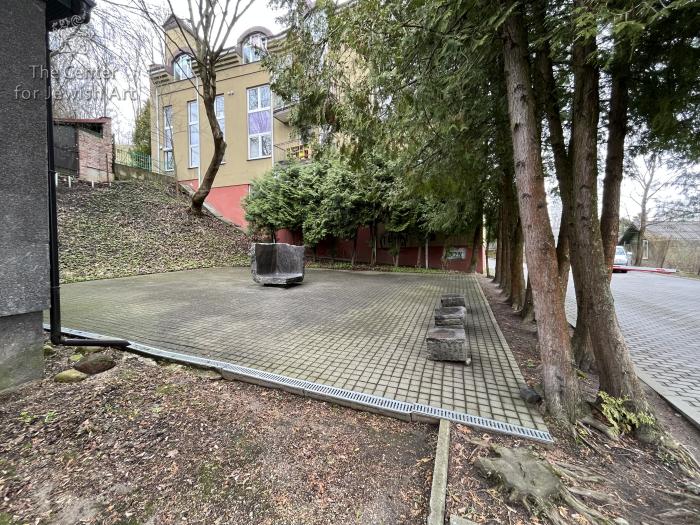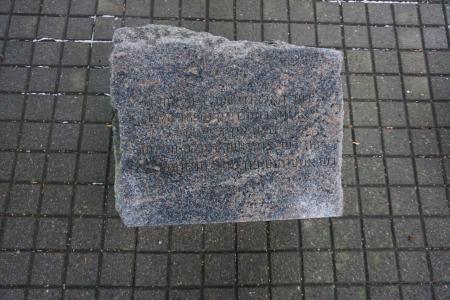Obj. ID: 45498
Modern Jewish Art Jan Zwartendijk Monument in Vilnius, Lithuania, 1999

Memorial name
Jan Zwartendijk Monument, or "The Corner"
Who is Commemorated?
Jan Zwartendijk, a Dutch consul, Righteous Among the Nations
Description:
The monument is located at the northwestern side of the Holocaust Division of the State Jewish Museum, not far from the Chiune Sugihara Monument.
The monument, made of dark polished granite, takes the form of three sides of a cube. According to the sculptor, the cube is a metaphor for human existence: “When something pushes into a corner, something creates a corner” (Marcišauskytė-Jurašienė 2014, 275).
On the western side of the monument, three low stones bear identical inscriptions in Yiddish, Lithuanian, and English.
Inscriptions:
In Yiddish:
דער האלאנדישער דיפלאמאט
יאן זווארטענדייק (1896 – 1976)
האט אין די יארן
פון דער צווייטער וועלט-מלחמה
געראטעוועט פון טויט טויזנטער יידן
In Lithuanian:
Olandų diplomatas
Janas Zwartendijkas
(1896-1976) Antrojo
pasaulinio karo metais
išgelbėjo nuo mirties
tūkstančius žydų
In English:
The Dutch Ambassador
Jan Zwartendijk
(1896-1976) rescued
thousands of Jews
during WWII
Commissioned by:
The State Jewish Museum (?)
sub-set tree:
Width and length - 110 cm
Thickness of the stone - 16 cm
Stones with inscriptions:
English: 45 x 42 x 26 cm
Yiddish: 52 x 49 x 26 cm
Lithuanian 43 x 42 x 26 cm
Jan Zwartendijk was director of the Lithuanian branch of production of Philips and the consul of the Netherlands in Kaunas, the provisional capital of the Republic of Lithuania. In 1940, he issued over 2,000 visas to Jewish refugees from Poland for entering Netherland’s colonies in the Caribbean, allowing Chiune Sugihara, the Japanese consul, to issue transit visas. This allowed the refugees to then obtain Soviet visas and to travel, via the Soviet Union, to Japan- thus escaping the Holocaust. Jan Zwartendijk was recognized as Righteous Among the Nations in 1997.
The monument was unveiled on June 4, 1999.
Agranovskii, Genrikh and Irina Guzenberg. Vilnius: Po sledam Litovskogo Ierusalima. Pamiatnye mesta ereiskoi istorii i kul’tury, 2nd ed. (Vilnius: The Vilna Gaon Jewish State Museum, 2016)., 450.
Guzenberg, Irina, Vilnius: Traces of the Jewish Jerusalem of Lithuania. Memorable Sites of Jewish History and Culture. A Guidebook (Vilnius: Pavilniai, 2021)., 462.
Guzenberg, Irina. Vilnius: Pamiatnye mesta evreiskoi istorii i kul'tury (Vilnius: Pavilniai, 2013)., 57.
Marcišauskytė-Jurašienė, Jolanta, Vilniaus skulptūrų kelias (Vilnius: Modernaus meno centras, 2014), 275.





















